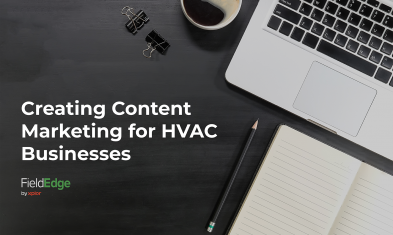Starting a plumbing business is exciting, but it’s no walk in the park! There’s a lot to know and a lot to do before you go out on your own and fix that first leaking toilet.
How can you prepare yourself for starting a plumbing business? We have some expert advice to lay a solid foundation for your business.
In this article, we will cover a series of tips to get your plumbing business off the ground, including:
- Getting certified and gaining experience as an apprentice
- Attaining licensing for your state
- Registering your business
- Creating a business plan
- Setting your pricing
- Developing a website and utilizing marketing strategies
- Creating a referral program
- Investing in plumbing software
1. Get Certified and Gain Experience as an Apprentice
What level of education do you need to work as a professional plumber? It doesn’t require a college degree, so you can become a professional plumber with a high school diploma or GED. However, you will have to be proficient in math, science and technology.
The key to starting a plumbing business is to get some real world experience before you try to launch. Start with a trade school or certification program where you can learn the ins and outs of basic plumbing. Completing trade school is a requirement to becoming a certified plumber.
During trade school, join a professional plumbing business as an apprentice. This can help you decide which types of plumbing you want to focus on.
Do you want to be a residential plumber, fixing leaks or installing pipes in a person’s home, or do you prefer larger commercial jobs? There are several different specialties available in the plumbing industry to explore.
2. Get Licensed For Your State
With the exception of a few states that don’t require a plumbing license, securing your business license is one of the first steps you should take in your plumbing journey.
Most require that you have completed trade school and taken an exam. The fees for the exam and applications vary from state to state.
Some states allow transferring a license from specific other states, this is called reciprocity. Other states require licensed plumbers moving across state lines to start fresh and apply for a unique license.
Be sure to do your research on licensing requirements before deciding which state your business will operate in, or which type of plumbing you want to practice!
3. Register Your Business
Registering your business is a critical next step to do BEFORE you launch your business. Think of it as the paperwork part of the business to make everything legal and on the up and up. It’s generally inexpensive to register your business with your state of operation.
An additional step is to register your plumbing business as an S Corp (i.e. S Corporation) or LLC (i.e. Limited Liability Company) that protects your personal assets should a dispute arise. It also helps you come tax time!
Each state has different licensing requirements and steps. Get the specific requirements from your local county or city office.
Make sure to run everything through your CPA before you file your paperwork to register your business. This will save an mistakes or oversights down the line. This is also a good time to purchase at insurance for your business, vehicles and employees as well.
4. Create A Business Plan
After registering and insuring your business, the next step is to create a plumbing business plan containing all your financial information.
It’s critical you craft this business plan before you start taking business calls. It will certainly be required for any financing your business may need (loans, investors and the like.)
A business plan is still very important even if you don’t need any financing to begin. It keeps everyone on the same page in your business, focused on the goals and visions of the company.
A basic business plan includes the following:
- Cover Page
- Executive Summary
- Business Overview
- Electrical Services
- Market Analysis Summary
- Business Strategy
- Implementation Summary
- Management Summary
- Financial Plan
Have your CPA review the final version to make sure you have everything included in your business plan – especially the financing portion. Then, it’s time to address your pricing.
5. Set Your Pricing
You don’t want to go into your first job without your pricing set – it should be a first step when setting up your business. Many plumbers might define their pricing during the creation of their business plan.
First, you have to decide how to price your jobs. There are basically two models used to set prices: time and materials and flat rate.
Time and Materials:
This is your basic pricing system where you charge a customer using a set travel rate, hourly labor rate and the material costs it takes to complete the job. So you don’t really have a price to offer them until the job is complete, only an estimate.
This sometimes leads to haggling over price if a job takes longer than expected and the customer doesn’t want to pay more than the original estimate. However, time and materials pricing can be beneficial as pricing is more flexible if the job takes longer than expected. Plus, efficient plumbers will likely be more profitable on the job.
Flat Rate
Flat rate pricing factors everything into an upfront price presented to the customer: set labor rate, parts, and materials and overhead.
Customers like to get an exact price before a job starts. However, plumbers have to be conscious that there is less room for unexpected factors when using flat rate pricing.
After determining your pricing system, you also want to look around at your competitors to see what they are charging. You don’t want to be the cheapest, and you also don’t want to be the highest price starting out.
6. Develop a Website and Utilize Marketing Strategies
Though many small businesses overlook this, you shouldn’t! As a new business, you will be able to secure some customers through word of mouth. But you want to be regarded as professional right from the start of your plumbing journey.
Credibility starts with a professional-looking website and some basic marketing. And don’t worry if you think you don’t have the web skills to build a website–there are many resources to have one built in a short amount of time!
Let’s dive into a few marketing basics for new plumbing companies:
Brand and Logo
Developing your brand and logo are an important part of your marketing that will be used everywhere: truck signage, website, business cards, uniforms and advertising. Here’s a few things to keep in mind when developing your logo:
- Colors: You want to stick to one or two colors in your logo. In your marketing, you may expand those two colors with some subtle variations or inverted color options depending on your background color.
- Stay consistent: When a customer looks at your website, your business card and truck, they should all look the same. Place the logo in the same place and stay consistent with your colors.
- Incorporate core values. Great logos represent your business mission statement. Examples of this may be loyalty or trust. Be sure to also create a short slogan as well to help stand out!
- Keep it simple. Keep the text to a minimum and don’t use drop shadows, gradients or a crazy font.
Your logo is the rock that branding is built on. Once you have your logo and key colors, you can build out your branding including fonts that you want to use, the type of graphics or imagery you want to use, and the message you want to convey to your audience.
Website
If you are building a website from scratch, check out the following website builders: WordPress, Squarespace or Wix. They are all geared toward building a first website.
Your website doesn’t have to be complicated, and can be easily expanded as your business and marketing efforts grow. Start with a home page, a page detailing the services you provide and a contact us page.
Other things to keep in mind as you build out your site include a maximum load time of 3 seconds (customers won’t wait for a slow loading website!), making sure your site works on a mobile phone and adding refreshing content.
Don’t forget to add a CTA (Call to Action) on your homepage. A CTA is a button and/or text that encourages visitors to take action by entering their email via a form or emailing your business’s address to learn more.
Social Media
When starting a plumbing business, social media can help you spread your message and build a strong online reputation for your brand. Consistent posting keeps your customers interested, makes you look credible, and doesn’t have to take a whole lot of effort.
What are some of the platforms you should use? As a plumbing business, start with Facebook and Instagram as they are popular and easy to use. LinkedIn can help with professional networking and gaining commercial clients. YouTube is great for posting videos and gaining trust with your audience.
Identify your key audience and base your platforms and posts on them. What would interest your audience? Adding graphics and videos to your posting cadence helps with engagement.
Here are a few things you can create posts about:
- Plumbing maintenance tips
- Positive reviews or testimonials about the work you’ve performed
- Company news or employee milestones
- Company events
- Employee volunteer projects
- Blogs that your company posted
Creating and sharing social media posts 2 or 3 times a week can really build a following, and help build credibility with your followers!
7. Rack Up Sales with a Referral Program
Word of mouth will get you jobs, but a referral program can help you expand your network. When you go above and beyond and the customer is happy, it’s time to ask for a referral!
Offering an incentive to give you a referral can also help some of those valued customers that need a little encouragement. You could offer a percentage off of their next service call for providing a referral. Or, you might also provide a simple reward for every referral – things like a branded insulated tumbler or a gift card to a local coffee shop can go a long way!
Once you finalize your referral program, let it be known! Promote it on your website or on your social media. Plumbing service software can also keep track of your referral program.
8. Invest in Plumbing Service Software
When starting a plumbing business, you want to arm yourself with the best tools to ensure your success.
That’s where FieldEdge plumbing software comes into play. This next level software can really help a new business establish itself by streamlining many of your daily tasks. Using tools like FieldEdge or FieldEdge Flat Rate Mobile can help smaller plumbing businesses grow rapidly.
What can FieldEdge Flat Rate plumbing software do for you? Here are just a few of the benefits:
- Get less pushback from customers with an upfront price
- Access to a database that is continually updated with latest parts and repairs, ensuring your price is right
- Integrate with QuickBooks, Google Calendar, Dropbox, and more!
Pump up your business with Plumbing software that streamlines all your processes – saving you time and money. Sign up for a FREE demo now!
Hit The Ground Running with Your Plumbing Business!
We’ve covered a series of tips to make sure you have all your ducks in a row when starting a plumbing business. You now have a better handle on:
- Getting certified and gaining experience as an apprentice
- Attaining licensing for your state
- Registering your business
- Creating a business plan
- Setting your pricing
- Developing a website and utilizing marketing strategies
- Creating a referral program
- Investing in plumbing software
Related: How to Create Stunning Plumbing Flyers & Doorhangers



